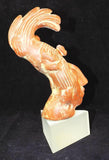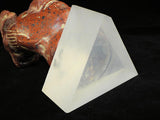Bust Of The Mayan King Pakal, Redware Handmade, Lucite Base.
Bust Of The Mayan King Pakal, Redware Handmade, Lucite Base, This Idealized Bust Of Pakal Associates The King with The Maya Maize God, His Hair Is Meant To Resemble Corn Silk, Maya Ideal Of Beauty, as Seen In The King’s Oval Face, Elongated Nose, and High Cheekbones. His Finely Sculpted Features and Realistic Portrayal Reveal The Naturalism Of Classic Maya Figurative Sculpture.

Picture Of The Bust of King Pakal The Great, From The Palenque Museum.
Maya beauty was a critical idea in the Mayan civilization, as it was with others. The Maya, just like people today, loved personal beauty, and they were willing to spend their wealth and endure much pain to achieve the perfect look. However, what they thought was beautiful differs in some respects from what people today find lovely. Here are some of the differences.
The Maya worshipped Yum Kaax, the Maize God, and to this god, they looked for their idea of beauty. Like an ear of corn narrows at the top, the Maya found an elongated head attractive. In a process called trepanning, Maya parents flattened a newborn baby’s soft skull so the forehead sloped up and backwards. Two boards were attached to the days-old baby’s head at an angle to press against the forehead. Maya parents increased the pressure of the boards over several days until the baby’s forehead sloped and the head was elongated. Experts once thought this deformation was limited to the nobility, but later evidence revealed that 90 per cent of the Maya skulls examined were elongated. A sloping forehead was a sign of being a Maya.
The Maya found slightly crossed eyes beautiful. To ensure their babies had this desirable feature, Maya parents made a headband for their infants and hung a piece of stone from a string between the baby’s eyes, hoping that the child’s eyes would cross.
A perfectly shaped nose, to the Maya, was rather large with a pronounced beak. From their artwork, we can see many Maya did have the perfect Roman profile of a big, beaked proboscis. If nature did not provide the ideal nose, many Maya resorted to a removable artificial nose bridge to give their nose the right hook shape.
Pointed teeth were beautiful teeth to the Maya, and they filed theirs to sharp points, often to form a certain pattern. Perhaps they thought pointed teeth resembled kernels of corn on the cob. Wealthy Maya would have inlays of precious stone like jade or turquoise drilled into their front teeth.
Maya pierced their ears, lips and noses. Men and women both sported earrings and earbobs, and jewellery worn in the lips and nose. As gold was not often found in Maya territory, precious gems and stones were predominantly used in jewellery. Jade and other green stones were especially favoured.
Maya men and women used body paint in patterns and solid colours. Unmarried men painted themselves black, priests used blue and men and women both favoured red. Warriors wore bands of alternating red and black paint. Tattoos were popular, but the process of getting tattooed was painful and often caused infection. A tattoo artist would paint the design on a Maya man or woman, then cut into the body along the lines of the design. The resulting scar and paint formed a tattoo. Maya tattoos were thus signs of personal bravery.
Item Code - CER2D127BAG
Width: 4 1/4" Height: 9 7/8" Depth: 5 1/4" Weight: 807 g













